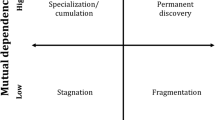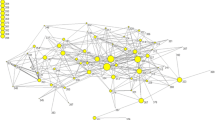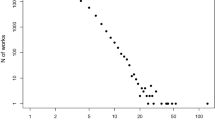Abstract
As digital humanities continues to expand and become more inclusive, little is known about the extent to which its knowledge is integrated. A bibliometric analysis of published literature in digital humanities was conducted to examine the degree of its intellectual cohesion over time (1989–2014). Co-authorship, article co-citation, and bibliographic coupling networks were generated so SNA based cohesion analysis can be applied. Modularity maximization partition was also performed to both co-citation and “author bibliographic coupling” networks to identify main research interests manifested in the literature. The results show that, as publications in digital humanities continue to grow, its diversity and coherence, two hallmarks of interdisciplinarity, have shown signs of becoming more robust. The co-author network, however, remained rather fragmented, with collaboration mainly limited by language and geographic boundaries. The domain specific practices in digital humanities that might contribute to such fragmentation was discussed.















Similar content being viewed by others
References
Acedo, F. J., Barroso, C., Casanueva, C., & Galán, J. L. (2006a). Co-authorship in management and organizational studies: An empirical and network analysis. Journal of Management Studies, 43(5), 957–983.
Acedo, F. J., Barroso, C., & Galan, J. L. (2006b). The resource-based theory: dissemination and main trends. Strategic Management Journal, 27(7), 621–636.
Archambault, É., Vignola-Gagné, É., Côté, G., Larivière, V., & Gingras, Y. (2005). Welcome to the linguistic warp zone: Benchmarking scientific output in the social sciences and humanities. In Proceedings of the ISSI 2005 conference (pp. 24–28).
Åström, F. (2007). Changes in the LIS research front: Time-sliced co-citation analyses of LIS journal articles, 1990–2004. Journal of the American Society for Information Science and Technology, 58(7), 947–957.
Blondel, V. D., Guillaume, J. L., Lambiotte, R., & Lefebvre, E. (2008). Fast unfolding of communities in large networks. Journal of Statistical Mechanics: Theory and Experiment, 2008(10), P10008.
Bordons, M., Morillo, F., & Gómez, I. (2004). Analysis of cross-disciplinary research through bibliometric tools. In H. F. Moed, W. Glänzel & U. Schmoch (Eds.), Handbook of quantitative science and technology research (pp. 437–456). Dordrecht: Kluwer.
Borgatti, S. P., Everett, M. G., & Freeman, L. C. (2002). Ucinet for windows: Software for social network analysis. Harvard, MA: Analytic Technologies.
Boyack, K. W., & Klavans, R. (2010). Co-citation analysis, bibliographic coupling, and direct citation: Which citation approach represents the research front most accurately? Journal of the American Society for Information Science and Technology, 61(12), 2389–2404.
Carolan, B. V. (2008). The structure of educational research: The role of multivocality in promoting cohesion in an article interlock network. Social Networks, 30(1), 69–82.
Condliffe Lagemann, E. (1989). The plural worlds of educational research. History of Education Quarterly, 29(2), 183–214.
Falagas, M. E., Pitsouni, E. I., Malietzis, G. A., & Pappas, G. (2008). Comparison of PubMed, scopus, web of science, and google scholar: Strengths and weaknesses. The FASEB Journal, 22(2), 338–342.
Fry, J. (2006). Scholarly research and information practices: A domain analytic approach. Information Processing and Management, 42(1), 299–316.
Gondal, N. (2011). The local and global structure of knowledge production in an emergent research field: An exponential random graph analysis. Social Networks, 33(1), 20–30.
Leefmann, J., Levallois, C., & Hildt, E. (2016). Neuroethics 1995–2012. A bibliometric analysis of the guiding themes of an emerging research field. Frontiers in Human Neuroscience, 10, 336.
Levallois, C., Clithero, J. A., Wouters, P., Smidts, A., & Huettel, S. A. (2012). Translating upwards: Linking the neural and social sciences via neuroeconomics. Nature Reviews Neuroscience, 13(11), 789–797.
Leydesdorff, L., & Salah, A. A. A. (2010). Maps on the basis of the Arts & Humanities Citation Index: The journals Leonardo and Art Journal versus “digital humanities” as a topic. Journal of the American Society for Information Science and Technology, 61(4), 787–801.
Liu, P., & Xia, H. (2015). Structure and evolution of co-authorship network in an interdisciplinary research field. Scientometrics, 103(1), 101–134.
Liu, X., Bollen, J., Nelson, M. L., & Van de Sompel, H. (2008). Co-authorship networks in the digital library research community. Information Processing and Management, 41(6), 1462–1480.
McCain, K. W. (1990). Mapping authors in intellectual space: A technical overview. Journal of the American Society for Information Science, 41(6), 433.
McCain, K. W. (1998). Neural networks research in context: A longitudinal journal cocitation analysis of an emerging interdisciplinary field. Scientometrics, 41(3), 389–410.
McCarty, W. (2005). Humanities computing. Basingstoke: Palgrave Macmillan.
Milgram, S. (1967). The small world problem. Phychology Today, 1, 61–67.
Moody, J. (2004). The structure of a social science collaboration network: Disciplinary cohesion from 1963 to 1999. American Sociological Review, 69(2), 213–238.
Moody, J., & White, D. R. (2003). Structural cohesion and embeddedness: A hierarchical concept of social groups. American Sociological Review, 103–127.
Morris, S. A., & Van der Veer Martens, B. (2008). Mapping research specialties. Annual Review of Information Science and Technology, 42(1), 213–295.
Nederhof, A. J. (2006). Bibliometric monitoring of research performance in the social sciences and the humanities: A review. Scientometrics, 66(1), 81–100.
Newman, M. E. (2001). The structure of scientific collaboration networks. Proceedings of the National Academy of Science, 98(2), 404–409.
Porter, A., & Rafols, I. (2009). Is science becoming more interdisciplinary? Measuring and mapping six research fields over time. Scientometrics, 81(3), 719–745.
Porter, A. L., Cohen, A. S., Roessner, J. D., & Perreault, M. (2007). Measuring researcher interdisciplinarity. Scientometrics, 72(1), 117–147.
Rafols, I., & Meyer, M. (2010). Diversity and network coherence as indicators of interdisciplinarity: Case studies in bionanoscience. Scientometrics, 82(2), 263–287.
Rawlings, C. M., McFarland, D. A., Dahlander, L., & Wang, D. (2015). Streams of thought: Knowledge flows and intellectual cohesion in a multidisciplinary era. Social Forces, 93(4), 1687–1722.
Stirling, A. (2007). A general framework for analysing diversity in science, technology and society. Journal of the Royal Society, Interface, 4(15), 707–719.
Svensson, P. (2010). The landscape of digital humanities. Digital Humanities, 4(1).
Vidgen, R., Henneberg, S., & Naudé, P. (2007). What sort of community is the European Conference on Information Systems? A social network analysis 1993–2005. European Journal of Information Systems, 16(1), 5–19.
Wagner, C. S., Roessner, J. D., Bobb, K., Klein, J. T., Boyack, K. W., Keyton, J., et al. (2011). Approaches to understanding and measuring interdisciplinary scientific research (IDR): A review of the literature. Journal of Informetrics, 5(1), 14–26.
Wang, X., & Inaba, M. (2009). Analyzing structures and evolution of digital humanities based on correspondence analysis and co-word analysis.アート・リサーチ, 9, 123–134.
Watts, D. J. (1999). Networks, dynamics, and the small-world phenomenon. American Journal of sociology, 105(2), 493–527.
Watts, D. J., & Strogatz, S. H. (1998). Collective dynamics of ‘small-world’ networks. Nature, 393(6684), 440.
White, H. D., & McCain, K. W. (1998). Visualizing a discipline: An author co-citation analysis of information science, 1972–1995. Journal of the American Society for Information Science, 49(4), 327–355.
Whitley, R. (2000). The social and intellectual organization of the sciences. Oxford: Oxford University Press.
Yan, E., & Ding, Y. (2012). Scholarly network similarities: How bibliographic coupling networks, citation networks, cocitation networks, topical networks, coauthorship networks, and coword networks relate to each other. Journal of the American Society for Information Science and Technology, 63(7), 1313–1326.
Zhao, D., & Strotmann, A. (2008). Evolution of research activities and intellectual influences in information science 1996–2005: Introducing author bibliographic-coupling analysis. Journal of the American Society for Information Science and Technology, 59(13), 2070–2086.
Author information
Authors and Affiliations
Corresponding author
Rights and permissions
About this article
Cite this article
Tang, MC., Cheng, Y.J. & Chen, K.H. A longitudinal study of intellectual cohesion in digital humanities using bibliometric analyses. Scientometrics 113, 985–1008 (2017). https://doi.org/10.1007/s11192-017-2496-6
Received:
Published:
Issue Date:
DOI: https://doi.org/10.1007/s11192-017-2496-6




